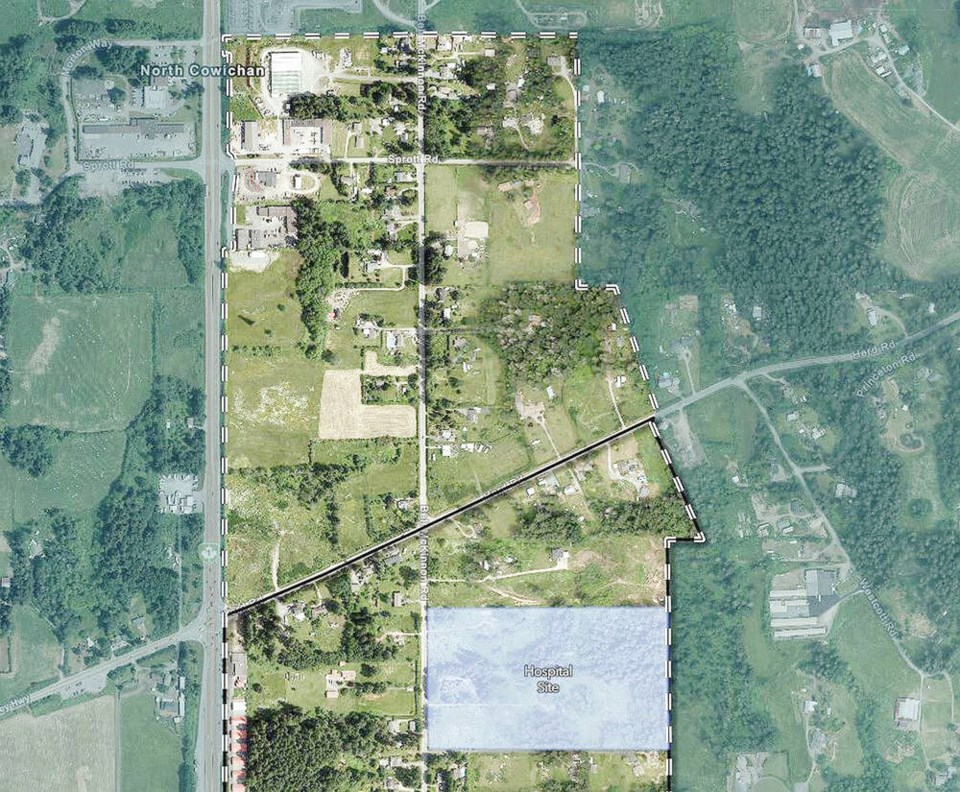North Cowichan is laying the groundwork for what its mayor calls a “new town centre” north of Duncan, near the new Cowichan District Hospital.
Development of the area around Bell McKinnon Road south of Herd Road, currently largely rural, would boost the number of homes in the municipality by more than 40 per cent.
About 6,000 new housing units are expected to be built as part of a phased plan, under proposed updates to the district’s area plan. In the 2021 census, the district had just over 13,700 dwellings.
Commercial development is also anticipated as the area grows.
Council is expected to vote on the four-phase plan for the development on Wednesday.
“Over the long term we are definitely looking at some pretty big changes here,” Mayor Rob Douglas said.
“What we’re talking about isn’t a few housing developments around the hospital. We’re basically creating a whole new town centre.”
The goal is to increase density in certain areas to avoid urban sprawl, foster creation of housing that’s more affordable and get better use of infrastructure, he said.
Construction of the new 204-bed Cowichan District Hospital is driving growth in the Bell McKinnon area, north of Cowichan Commons — the shopping area on the west side of the Trans-╬┌č╗┤½├Į Highway between Green and Drinkwater roads.
Douglas said buildings in the new development would likely be up to about three to four storeys high, although the build-out timeline will depend on market forces and interest rates.
Upgraded and new infrastructure is critical to shaping development in the area, he said.
Funding for the new hospital, scheduled to open in 2027, includes a new sewer main and new water main on Bell McKinnon Road, which will service the hospital and support development in the surrounding area, Douglas said.
Another $22 million is required to get development going, he said, since upgrades are needed for a sanitary sewer pump station and the main sewage-treatment plant and a new water reservoir has to be built.
The district’s goal is to have developers rather than general taxpayers pay for infrastructure improvements, he said.
Those properties closest to the new infrastructure would develop first, he said. Once an area nears the build-out phase, the next phase of development could begin for areas not immediately next to infrastructure.
A “latecomer agreement” would see new development contribute to the earlier infrastructure costs.
About 150 independently owned parcels of land are located within the Bell McKinnon area proposed for development, so planning requires more co-ordination than a master-planned community where land is held by one owner, staff said in a report to council.
Phase one covers 19 hectares west of the Trans-╬┌č╗┤½├Į Highway, where rezoning applications are being accepted. The policy calls for about 777 dwellings once it is built out. A large amount of the area is already developed or has zoning in place allowing for development.
Phase two surrounds the new hospital site and covers 48.4 hectares fronting onto Bell McKinnon Road south of Herd Road. The district anticipates 3,179 new dwellings plus commercial and institutional uses in the area.
Phase three is 42.1 hectares and is made up of all other properties south of Herd Road near Bell McKinnon, with an expected 1,766 new dwellings plus commercial areas.
The final phase would be for about 43.7 hectares north of Herd Road and could not go ahead without official community plan changes. It would have room for slightly more than 2,000 dwelling units plus commercial space.
Once development thresholds are met in the first three phases, council would be in a position to consider if it wants to open lands north of Herd Road for development, Douglas said.
Still to be worked out is an interim replacement for an outdated development cost charge bylaw. The current rates do not generate enough revenue to pay for needed infrastructure to facilitate development, Douglas said.
The bylaw will likely not be updated until next year, followed by another 12 months before the rates take effect, he said. But the district needs a policy in the interim to obtain money from development to cover infrastructure costs, with a small amount to go toward affordable housing.
Concern about how that would work led to a tie vote when the mayor proposed an interim plan to help pay for infrastructure costs at committee of the whole this week.
However, Douglas is optimistic that an interim funding model for infrastructure will be resolved by the next council meeting.
Policies around development in this area would include public engagement and are being designed to be flexible, he said.
>>> To comment on this article, write a letter to the editor: [email protected]



